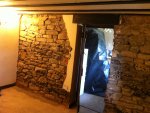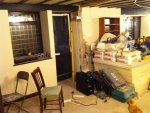philhjobim
New member
I am adding thermal insulation to a very cold room which is a converted stable with thick stone walls. Half of the exterior walls are also underground.
The ceiling plasterboard will be taken down and 75mm PIR foam sheet placed up into the cavities between the 5inch joists.
I would welcome advice on how to finish the ceiling surface, for the room to sound good for hifi listening and playing acoustic guitar.
The floor will be concrete>30 mm PIR foam sheet>22mm chip flooring>thick carpet
Three walls are thick stone>gap>concrete block tanking wall>50mm PIR foam sheet> surface finish will be decided last to allow adjustment to the acoustic.
One end wall is exposed original stone blockwork.
Room dimensions 7.0m long X 3.7m wide X 2.1m high
Thanks, Phil
The ceiling plasterboard will be taken down and 75mm PIR foam sheet placed up into the cavities between the 5inch joists.
I would welcome advice on how to finish the ceiling surface, for the room to sound good for hifi listening and playing acoustic guitar.
The floor will be concrete>30 mm PIR foam sheet>22mm chip flooring>thick carpet
Three walls are thick stone>gap>concrete block tanking wall>50mm PIR foam sheet> surface finish will be decided last to allow adjustment to the acoustic.
One end wall is exposed original stone blockwork.
Room dimensions 7.0m long X 3.7m wide X 2.1m high
Thanks, Phil

 How big is the room (including ceiling height)? Do you want permanent acoustic treatment? A 2" ceiling cloud, suspended a few inches below the hard surface is good.
How big is the room (including ceiling height)? Do you want permanent acoustic treatment? A 2" ceiling cloud, suspended a few inches below the hard surface is good. Some people like to listen to music anyhow in a room that has an acoustic good enough for tracking......
Some people like to listen to music anyhow in a room that has an acoustic good enough for tracking......

